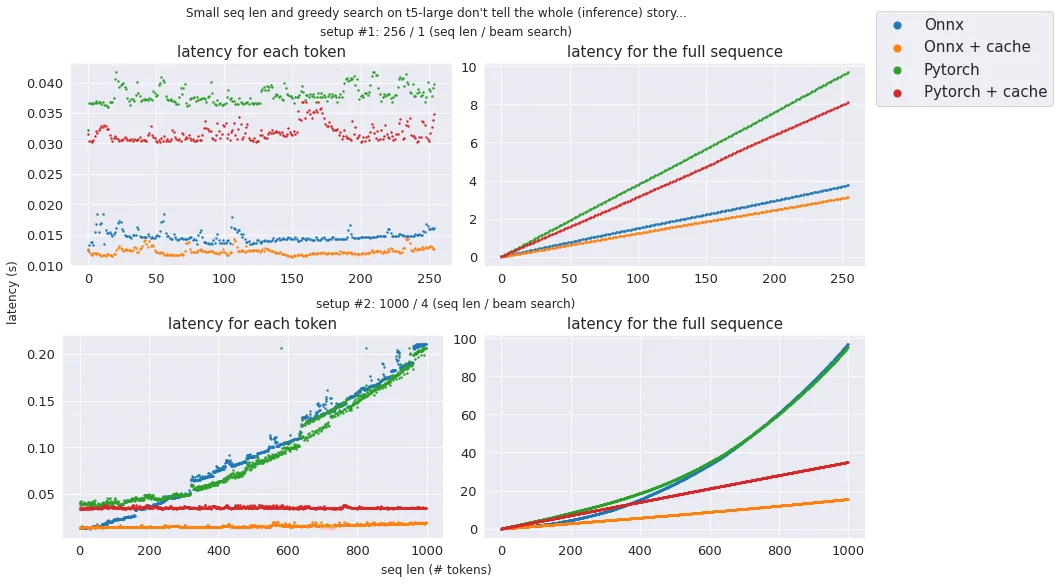What we learned by making T5-large 2X faster than Pytorch (and any autoregressive transformer)
We made autoregressive transformer based models like T5-large 2X faster than 🤗 Hugging Face Pytorch with 3
simple tricks:
-
storing 2 computation graphs in a single
Onnxfile 👯: this let us have both cache and no cache support without having any duplicated weights. When cache is used, attention switch from quadratic to linear complexity (less GPU computation) andOnnx Runtimebrings us kernel fusion (less memory bound ops); -
zero copy 💥 to retrieve output from
Onnx Runtime: we leverageCupyAPI to accessOnnx RuntimeinternalCUDAarrays and expose them throughDlpacktoPytorch. It may sound a bit complex, but it let us avoid output tensors copy which limit our memory footprint and make us much faster (check notebook for other benefits of this approach); -
a generic tool to convert any model (whatever the architecture) to
FP16: it injects random inputs in the model to detect nodes that need to be kept inFP32because "mixed precision" is more complicated on large generative models (usual patterns don't work at large scale).
notebook: https://github.com/ELS-RD/transformer-deploy/blob/main/demo/generative-model/t5.ipynb (Onnx Runtime
only)
project: https://github.com/ELS-RD/transformer-deploy/
For
TensorRTwe have our own implementation of our approach described above which helps to provide similar latency toOnnx Runtime. It's in a dedicatedPythonscript in the same folder as the notebook. We had to work around a documented limitation. Because of that the code is slightly more complex and we wanted to keep this notebook easy to read.https://github.com/ELS-RD/transformer-deploy/blob/main/demo/generative-model/t5_tensorrt.py
The challenge
We plan to use large autoregressive models like T5 mainly for few shots learning but they tend to be slow.
We needed something faster (including long sequences, large models, etc.), easy to deploy (no exotic/custom
framework/hardware/kernel) and generic (works on most generative transformer models, NLP related or not, compatible
with Onnx Runtime and TensorRT that we are using for other stuff).
In most situations, performing inference with Onnx Runtime or TensorRT usually brought large improvement over
Pytorch/Hugging Face implementation.
In the very specific case of autoregressive languages, things are a bit more complicated. As you know (if not, check the notebook above for a longer explanation), you can accelerate an autoregressive model by caching Key/Value representations. By using a cache, for each generated token, you are switching from a quadratic complexity to a linear one in the self/cross attention modules. Only the first generated token is done without cache.
Hugging Face is using this mechanism. When you export your model to Onnx using tracing, any control flow instruction
is lost (including the If instruction to enable or not a cache).
All the T5 inference solutions we found seem to suffer from it (a list of existing solutions and their issues is provided in the notebook).
Performance analysis and next steps
With our simple approach, we have made the inference latency mostly linear to the sequence length.Profiling the GPU with Nvidia Nsight shows that GPU computation capacities are mostly unused. It likely means that we are memory bounded, it would make sense as for each step, we just perform computations for a single token.
Going deeper in the analysis, Onnx Runtime profiler confirms that we are memory bounded and spend lots of time on
casting to FP16/FP32. A strategy to increase performances would be to reduce the number of casting nodes (by a second
pass on the graph to remove unnecessary casting nodes).
Second point, MatMul (the only operation where GPU computation capacities are fully used) represent a little part of
the latency because now attention is computed for only one token (excepted the first one). It means that after these
transformations of the computation graph, kernel fusions to reduce the number of memory bounded operations should pay
off in a much bigger way than it did in the past. Hopefully such kernel fusions will land in both TensorRT and Onnx
Runtime soon.
Nvidia Triton server deployment will be released when Onnx Runtime 1.12 will be supported (ORT 1.12 should be
released in June, and Triton... soon after ?).
If you are interested in these things, you can follow me on twitter: https://twitter.com/pommedeterre33


